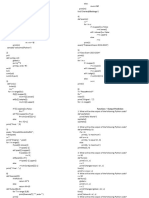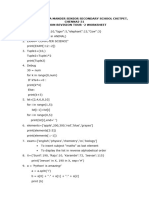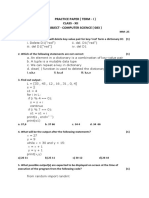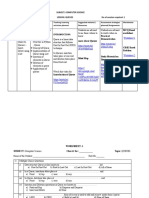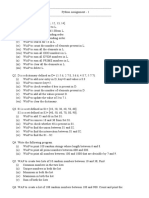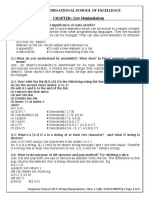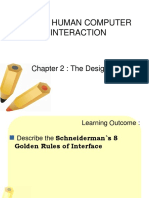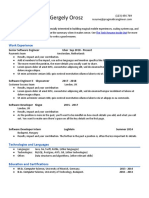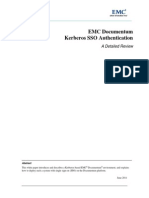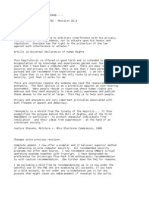VELAMMAL VIDYALAYA – SHOLINGANALLUR.
XII - COMPUTER SCIENCE (083)
Python Revision Tour 2
1. For a given declaration in Python as s=”WELCOME”
Which of the following will be the correct output of print (s[1:2])?
a. WEL b. COME c. E d. ECM
2. Given a Tuple tup1= (10, 20, 30, 40, 50, 60, 70, 80, 90).
What will be the output of print (tup1 [3:7:2])?
a. (40,50,60,70,80) b. (40,50,60,70) c. [40,60] d. (40,60)
3. Consider a tuple tup1 = (10, 15, 25, and 30). Identify the statement that will result in
an error.
a. print(tup1[2]) b. tup1[2] = 20 c. print(min(tup1)) d. print(len(tup1))
4. Which of these about a dictionary is false?
a. The values of a dictionary can be accessed using keys
b. The keys of a dictionary can be accessed using values
c. Dictionaries aren’t ordered
d. Dictionaries are mutable
5. What is the output of following code?
T=(100) print(T*2)
a. Syntax error b. (200,) c. 200 d. (100,100)
6. Identify the output of the following Python statements.
x = [[10.0, 11.0, 12.0],[13.0, 14.0, 15.0]]
y = x[1][2] print(y)
a. 12.0 b. 13.0 c. 14.0 d. 15.0
7. Given the lists L=[1,3,6,82,5,7,11,92] , write the output of print(L[2:5])
Ans:-
1
�13. Write a statement in Python to declare a dictionary whose keys are 1, 2, 3 and values
are Monday, Tuesday and Wednesday respectively.
14. What is the output of the expression? STR=”trip@split” print(STR.rstrip(“t”))
a. rip@spli b. trip@spli c. rip@split d. rip@spli
15. What will be the output of the following code snippet?
gist=”Old is Gold”
X=gist.partition(“s”) print(X[-1:-3])
a. () b. (' Gold') c. (' Gold', 'is') d. None of the above
16. What will be the output of the following code?
MainList = ["One", ["2", "3"], "4"]
CheckList = [ MainList[1] ] print(CheckList)
a. [“2”] b. [“2”, ”3”] c. [ [“2”,”3”] ] d. Syntax Error
17. If “dict” is a dictionary as defined below, then which of the following statements
will raise an exception?
dict = {'Rose': 10, 'Lily': 20, 'Sunflower': 30}
a. dict.get('Sunflower') b. print(dict['Rose', 'Lily']) c. dict['Rose']=40 d. print(str(dict))
18. Identify the invalid python statement from the following:
a. t=(100) b. t=tuple() c. t=(100,) d. None of the above
19. Write the output:-
myTuple =("Ajay", "Siva", "Vicky")
x = "#".join(myTuple) print(x)
a. #Ajay#Siva#Vicky b. Ajay#Siva#Vicky
c. Ajay#Siva#Vicky# d. #Ajay#Siva#Vicky#
2
�27. Identify the invalid statement for list L= [1,2,3,4]
a. L.remove(3) b. L.pop(3) c. L.del(3) d. del L[3]
28. What will be the output of the following Python statements?
D={‘BHUSHAN’:90, ‘SAKSHI’:96,’RANJIT’:85} print(‘RANJIT’ in D,
96 in D, sep=’@’)
a. True@True b. False@True c. True@False d. False@False
29. What will be the output of the following code?
s = [3,0,[2,1,2,3],1] print(s[s[len(s[2])-2][1]])
a.0 b. 1 c. [2,1,2,3] d. 2
30. Which of the following statement(s) will raise an exception? Sales
= {"Printer":25000,"Mouse":750 } # Statement 1
print (Sales[750]) # Statement 2
Sales ["Printer"]=12500 # Statement 3 print
(Sales.pop()) # Statement 4 print
(Sales) # Statement 5
a. Statement 2 b. Statement 3 c. Statement 4 d. Statements 2 and 4
31. Which of the following will delete key-value pair for key = “Red” from a dictionary
COLOR?
a. delete COLOR("Red") b. del COLOR["Red"]
c. del.COLOR["Red"] d. COLOR.del["Red"]
32. What will be the output of the following code?
L1 = [1, 2, 3]
L2 = L1 L1 +=
[4,] print(L1 =
= L2)
a. True b. False c. tuple1 d. Error
3
�a. 'DATA=Science=DataScience=And' b. 'DATA=DataScience=And'
c. 'DATA=Science=And' d. 'DATA=Science==DataScience=And'
39. What will be the output of the following code?
tuple1 = (1, 2, 3) tuple2
= tuple1 + (4,) tuple1
+= (5,) print(tuple1,
tuple2)
a. (1, 2, 3) (1, 2, 3, 4) b. (1, 2, 3, 5) (1, 2, 3) c. (1, 2, 3, 5) (1, 2, 3, 4) d. Error
40. Identify the output of the following code snippet:
str = "KENDRIYA VIDYALAYA"
str=str.replace('YA','*') print(str)
a. KENDRIYA VIDYALAYA b. KENDRI*A VID*ALAYA
c. KENDRI* VID*LA* d. * KENDRI* VID*LA*
41. State the correct output of the following code-
S1= “India is on the Moon”
A=S1.split("o",3) print(A)
a. ['India is ', 'n the M', ' ', 'n'] b. 'India is ', 'n the M', ' ', 'n'
c. ['India is n ', 'the ', ' ', 'Mn'] d. [„India is‟, „the‟, „n‟]
42. State the correct output of the following code- str1="
Programming " str2=" is My Junoon"
str3=str1.strip()+str2.replace("J", "j").lstrip() print(str3.partition("My"))
a. ('Programmingis ', 'My', ' junoon') b. ['Programmingis ', 'My', ' junoon']
c. ['Programming is ', 'My', ' Junoon'] d. (('Programmingis ', 'My', ' Junoon')
4
�49. What will be the output of following code if a = “abcde”
A [1:1 ] == a [1:2]
Type (a[1:1]) == type (a[1:2])
50. Identify the output of the following python code:
D={1:”one”,2:”two”, 3:”three”}
L=[]
For k,v in D.items():
If ‘o’ in v:
L.append(k)
Print(L)
(a) [1,2] (b) [1,3] (c)[2,3] (d)[3,1]


